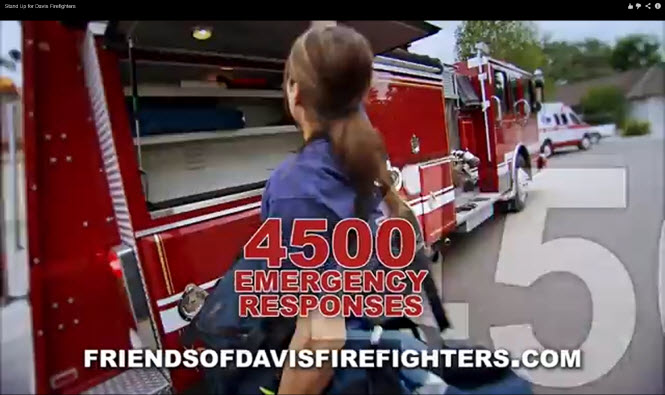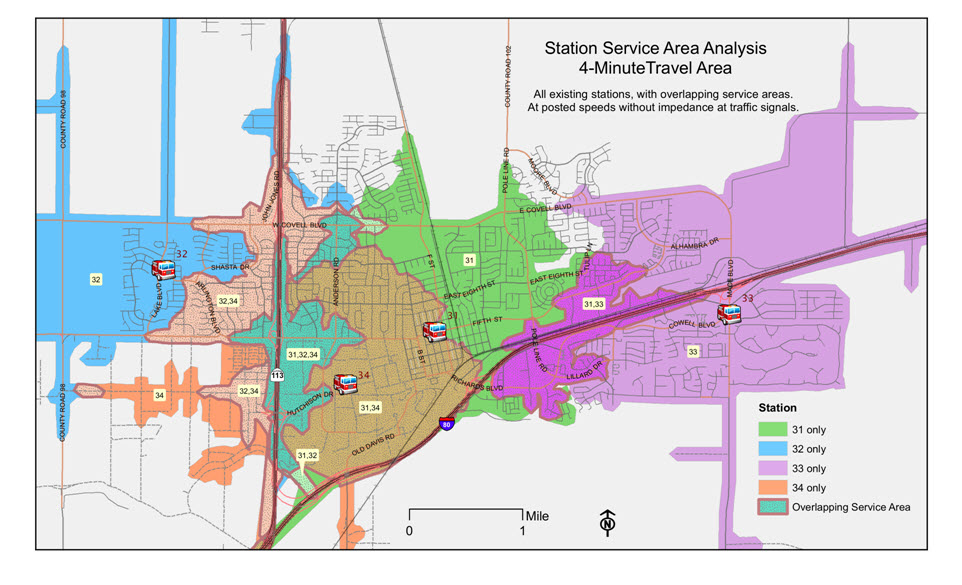 Vanguard Analysis Demonstrates that Public Safety Was Sacrificed in An Effort to Show Necessity of Fourth Fire Station – On Tuesday night, the Davis City Council will hear yet another iteration of the fire staffing report. This time, it will be in the framework of a broader budgetary discussion.
Vanguard Analysis Demonstrates that Public Safety Was Sacrificed in An Effort to Show Necessity of Fourth Fire Station – On Tuesday night, the Davis City Council will hear yet another iteration of the fire staffing report. This time, it will be in the framework of a broader budgetary discussion.
The Davis firefighters are organizing some in the community around the idea that reductions in staffing from 12 to 11 will risk public safety by increasing response times and delaying entry into buildings that are on fire.
However, the Vanguard examination of the combination of fire department response policies over the last twenty years, calls for service data, and the lack of boundary drop with UC Davis reveals that current policies actually act against public safety and, more importantly, that those policies appear to have been implemented not with public safety in mind, but rather as a tool to force the Davis City Council to build a fourth fire station.
A close examination of this new information reveals that the city could resolve most of the concerns of residents about the staffing changes by a common-sense redeployment, moving Station 31 north from 5th Street to North Davis.
Under ordinary conditions we would have to write off that move as a future hope – however, Davis has an opportunity. ConAgra has been lobbying council to rezone the Cannery Project so it can develop a new mixed-use housing development. We have been reluctant to do so, however, building the new fire station on Covell on the southeastern portion of the project is a community benefit that would be well worth exploring.
This is the map that former Fire Chief Rose Conroy and firefighters union president Bobby Weist did not want the public to see.
It shows the four-minute travel zone within the city of Davis. The critical area to focus on is the overlap between Station 34 (UC Davis’ fire station) and Station 31, which is the central fire station. The map shows that Station 34’s four-minute zone ends at Station 31.
That means, in a world where we have boundary drop, Station 31 is misplaced. Station 34 can comfortably respond to a huge area currently covered by Station 31. By moving Station 31 up to Covell, the station can still cover its current zone, but could then also reasonably cover Wildhorse and the northern areas to the west, easily within the four-minute travel time.
This move would not be able to occur without boundary drop – the policy decision that would allow Station 34 to be the first responder into Davis neighborhoods. The firefighters appear to have opposed boundary drop, in part driven by the hope that, instead of moving Station 31 from 5th Street, the council would simply approve a fourth fire station.
The firefighter’s support for Covell Village was predicated on the promise of a fourth fire station. However, boundary drop makes that fourth fire station entirely unnecessary. Instead, the city can simply move the central station north and allow UC Davis to cover the core area shown on the map.
This is, however, just the tip of the iceberg. Because the city’s firefighters fought boundary drop with the UC Davis Fire Department, the city was left very vulnerable in the case of simultaneous calls.
According to data from the city, because of deployment policies, Station 32 had to leave its area uncovered 262 times in the past year to cover Station 31 when the station was out on a call. 345 times, Station 33 had to come into Station 31’s area leaving east Davis effectively uncovered and making for much longer response times for fires and medical emergencies.
The city’s data analysis demonstrates that using UC Davis’ fire station would have eliminated this problem of simultaneous calls.
Under the leadership of Chief Rose Conroy, the city, rather than contracting with UC Davis to cover to the city during these times, had the policy of calling the much further West Sacramento or Woodland units to cover these outlying stations, with Station 34 being called only when those outside agencies either had not yet arrived or their stations were tied up with their own emergencies and could not be redeployed.
It gets worse. One of the reasons that Station 31 was out of its area so frequently reflects another confluence of conscious policy decisions. Under current policy, Station 31’s rescue apparatus is required to respond to all traffic accidents regardless of where they occur in the city.
That problem is compounded by the fact that Engine 31 is required to work in tandem with the rescue apparatus. This again left the area that Station 31 served uncovered and the city moved one of the outlying stations to Station 31 to backfill, leaving their area uncovered.
Under Chief Kenley’s plan, opposed by the firefighters’ union, the rescue apparatus would be uncoupled from Engine 31, allowing it to independently respond to auto accidents while allowing Engine 31 to remain available to respond to calls.
Information that the Vanguard received indicates that there was a time when Station 31 had more than minimum staffing and they could have uncoupled the two even under the current staffing model, but Chief Conroy refused to do so, perhaps to demonstrate the problem of simultaneous calls as impetus to lobby council for a fourth fire station.
Furthermore, there are times when a medical emergency requires a firefighter to remain on the ambulance until it arrives at the hospital. Policy under Chief Conroy did not allow the engine, now down to three firefighters, to return to active status and respond to calls.
It would appear that all of these policies were geared not toward the safety of the public or, even in most cases, the safety of firefighters themselves, but rather the policy goal of convincing the Davis City Council to build a fourth fire station, which would have been staffed by four additional firefighters per shift or 12 total.
The cost of that decision would have not only been the cost of building the fire station, but the ongoing staffing, probably upwards of $2 million each year (assuming the current $170,000 total compensation cost) and perhaps more if it required an additional Division Chief and administration.
Instead of fixing the problem of simultaneous calls through boundary drop, more sensible mutual aid agreements, and decoupling Engine 31 from the rescue apparatus, the former Chief appears to have intentionally designed a policy that, by its very nature, created a false crisis of simultaneous calls and, by its very nature, made the community less safe.
Decoupling the rescue apparatus from the fire engine, which will now be staffed with three firefighters, allows the engine to remain in place during medical calls and traffic accidents. These represent the vast majority of all calls, with only seven working structure fires per year.
Boundary drop is an obvious no brainer. There has been some talk this week that UC Davis itself is a barrier to the boundary drop, insisting that its own units have sole access to sensitive research facilities on campus. However, John Meyer told the Vanguard that, while the Davis firefighters have raised the issue as a concern, UC Davis has told Steve Pierce that they “have no such concerns.”
While boundary drop and the response timelines suggest that the best strategy is to move the fire station northward, the cost of such a move would be prohibitive, particularly during these tough economic times.
However, we believe that the city has an opportunity here. We have had concerns about the Cannery Project from the standpoint of housing needs and other issues. However, if the developer would build a fire station on that site in conjunction with the rest of their project, that would constitute a significant community access.
Moving the fire station to Covell would allow the northern areas to the east and west of Pole Line to remain under the four-minute response time and still allow both UC Davis and the newly-located Station 31 to keep the core of town covered within a four-minute travel time.
It would be a bold move and would require significant negotiations. However, it would likely clear the way for the council to approve the new Cannery Project, knowing that it would improve public safety and in the long run save the city money, as it would no longer need to build a fourth fire station.
From a public safety standpoint, this would be the final piece to the puzzle, eliminating both the problem of simultaneous calls that would be served by both UC Davis and the decoupling of the rescue apparatus, while at the same time ensuring that Wildhorse and North Davis would all be under the four-minute travel time.
The only true barrier is a firefighters’ union that still believes that they will get a fourth fire station and have opposed all efforts for reform, as well as refused to take concessions that the city’s other employees have already taken.
—David M. Greenwald reporting







Hi David
Please provide map
is there a timeline for the boundry drop and is it on track?
“Please provide map “
That might be helpful. Done. Click to enlarge.
“is there a timeline for the boundry drop and is it on track? “
I don’t believe there is a timeline, there is a sub-committee and I received some conflicting information this week as to whether it is on track. It will be implemented, part of that will depend on the staffing decision. We should know more by the end of Tuesday’s meeting.
We don’t need to add a fourth fire station apparently we have had one hiding in plain sight. We only need to reconfigure the four that we have, relocating one of them to the new Cannery project. If David’s analysis is true I like it.
This is the key point Mr. Toad:
Here’s a map, the left side depicts the current deployment of stations, and the map on the right shows the deployment I’m proposing. (Firestations are in black for illustrative purposes)
[img]images/stories/Fire-Station-Map.png[/img]
It doesn’t take a lot of hard analysis to see this is a better deployment model as you can cover much more of the city in the response time. Both 34 and 31 would have five people. 34 has a three person engine and a two person truck and 31 would have a three person engine and a two person rescue apparatus.
Short correction. UCD station 34 staffs 3 full time ff engine and a 3 or 4 full time FF ladder truck .
(the 4th ff on the truck is for overtime relief and if a full time firefighter is sick or on vacation fills the missing role staffing the truck at 3 ffs)
Additional staffing when available is provided by UCD student firefighters at up t 2 additional on the fire engine and up to 3 or 4 additional on the ladder truck. total of 5 (E34) and 7 (T34) firefighters each.
Thanks for the correction. This bolsters my point that UCD can easily cover an emergency in Davis and still remain in position for another call.
No Problem.
Has anyone from the city openly discussed inclusion of a fire station in the cannery project as a condition for approval or is this at this point just the Vanguard’s idea? Regardless, it’s a good idea and a common requirement for a significant development. Hopefully the city is receptive to the idea.
A few appear interested in the idea. But I don’t know to what extent it has been examined or if ConAgra would be willing.
Wouldn’t former Fire Chief Rose Conroy have been working for the city as part of management rather than working for firefighters union president Bobby Weist? You seem to be putting them in the same pot, sharing identical motives and goals, with Rose ignoring her primary responsibilities and her supervisor.
Remember the Aaronson report criticized her for being too close to the union.
” You seem to be putting them in the same pot, sharing identical motives and goals, with Rose ignoring her primary responsibilities and her supervisor. “
That would be my view of the situation.
And, every time we see a little more evidence (thanks a lot to your digging), we find a surprising lack of responsible leadership on her part. We took pride in having an early, woman chief. Now, it appears that she got co-opted, then rolled (radicalized?) by a tough guy. “Just like a …..”
one way i know this is accurate is if it weren’t, someone would have refuted it already. one thing i can tell – firefighters ignore greenwald at their own peril. he has council’s ear.
One thing that should be remembered is that most all who rise to the fire chief ranks started as simple firefighters and therefore most likely union members. Just because you promote to be a chief ie management does not mean you automatically change perspective. This seems especially true when a chief, such as Chief Conroy, promotes from within the organization as opposed to changing departments. The same people you worked closely with, lived one third of your working life with, and often are very good friends with are still there and who really wants to alienate ones best friends?
At the end of the day Chief Conroy always went to bat for her firefighters. Depending on perspective she could be admired for sticking up for her firefighters or criticized for selling the farm to the animals. I do not doubt she believes she did the right thing for the city and her employees.
Hearing that the ConAgra folks don’t like the idea of a fire station but that one on Pole Line and Covell might be possible without committing to a broader project.
nvn8n wrote:
> One thing that should be remembered is that most all
> who rise to the fire chief ranks started as simple
> firefighters and therefore most likely union members.
I thought that all fire management in CA were union members (unlike management of most private companies). Does your department require people to leave the union (and stop paying union dues) when they rise to the rank of Chief?
Chiefs are non-unionized, but that does not mean they are not union-sympathizers.